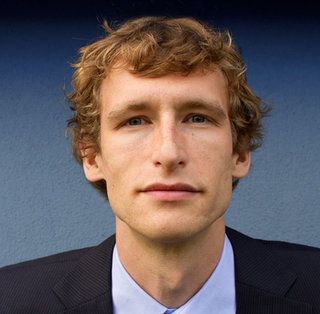Interview with
Work Package 4 Leader

Alexander Berlin
Business Support
What is, in your opinion, the most important legacy of IoF2020?

The first legacy will be the business model toolbox, which is an interactive model and is re-usable by all the other innovation hubs. It consists of an ecosystem mapping, with an interactive map of all the partners of IoF2020. There will be a business model component builder with what we learnt from all IoF Use Cases: we dismantled their business models into components and gave a bit of context behind it. We know already of companies which are using these business model components “in the real world” and provide us with feedback. The business model visualization is a part of this as well, it will be basically an interactive discovery the business models of the used cases. You can click on certain parts to get information about the ecosystem of the Use Case, the value proposition, the IoTs pack, the business part etc. We also try to make a catalog of these visuals, so someone who is working on the visualization of their business model or value proposition can break this visualization apart and reuse the components.

We are also working on the joint corporate innovation program, which is basically a business model concept we developed for the digital innovation hubs (DIHs), to exploit their services in a better way, by proposing their innovations services jointly on a platform. We are working on their current partner mapping, strength mapping. The concept was developed in IoF2020 because we identified a need to sustain the support, we were giving to the DIHs and the fact that most of them did not have a concrete business model.

We learnt from the IoF2020 participating companies, especially the medium and smaller ones, that they are lacking connections to the ecosystem. The smaller companies are very important in innovation, but they are not always making use of the international innovation services because they think it is too expensive or that they do not know who to contact. That is why we want to offer one centralized network.

Then we have the European Digital Test Farm Network. This is the idea to sustain the 140 test farms or test sites that we created within IoF2020 and combine them with other existing projects. It could be the EIT Food project, the Nefertiti project or the French network, and some corporate test farms as well. We want to come up with a common way of measuring KPIs on these test farms so that we have an opportunity to benchmark solutions in the future. But also to give better feedback on the development cycle: we saw that in IoF2020 we did not always have professional test farms, so there were some problem to get professional feedback. We had sometimes to drop some farms due to this and spend time to find new farms. We have now all the partners together and that would be another spin-off project.

We did quite some work on User acceptance (UAT) side. We developed our own questionnaire for agri-food tech that we put into REACH OUT, which is another European Commission project supporting H2020 and Horizon Europe projects in relation with UAT testing. We helped them to have a standardized agri-food tech component. This can be used to evaluate UAT for future agri-food tech project.
Looking back on your participation to IoF2020, what were some of the challenges that your work package encountered?

One of the major challenges that we encountered was that we took longer to develop products than what was originally planned. We had to learn that the agricultural world is not yet working like the start-up world. There are no beta versions, prototypes are being pushed to the test farms and they are not so many of them. At the beginning, our idea was to have business model cycles, and to see what works or not in the market and then adapt it. That was unfortunately not possible because most of the companies we were working with did not have a market-ready product. We had to work in a more theoretical way, making predictions on the costs structure for instance.

Another challenge is that we were missing the involvement of the lower part of the value chain: the end-consumers, the supermarkets. We saw in several business models, that in order to make use of the data, we needed to connect with the whole value chain. We were focusing more on the production and processing industries.

Another challenge is that the Use cases were especially diverse in their development stage. We had been working with highly developed companies, which required few inputs, with already a business model and products on the market. New companies would have new products, often created during research. They would not always know how to place themselves and the product on the market. We had to provide support at different levels.

The KPI measurement was a challenge we expected. It is always hard to measure KPI in an agricultural environment, which is influenced by weather or diseases. We also experienced that IoT based KPIs or KPIs related to sustainability, food quality, were never measured before. We had issues to measure a baseline, and so to measure our impact. In many cases it was difficult, we would have had to start measuring 1 year before the implementation. We did not define a final golden rule, it must be further developed, for example within the European Test Farm network.

We did not take sustainability much into account at the beginning of the project. But with Farm2Fork for instance, has it come up during the project, we had to react and adjust our KPIs.
What would be your recommendations to young farmers who are hesitating to join such projects/use such technologies?

We see that in the future CAP, there is a focus on the consumer wishes, on producing better quality food and in a more sustainable way. But producers have difficulties to find the right technologies, the right support and financing to implement this agricultural transition. If I am a young farmer and I want to learn more, I should go to the IoT catalog to see the available options. We want to align all the research projects still starting under H2020, to make sure that everyone knows about the IoT catalog, the SmartAgriHubs portal… And allow any farmer to find resources, categorized objectively.

Currently, under the H2020 scheme, it was rather complicated for smaller companies and smaller farms to join these large projects. T The Commission seems to be working on a different structure for Horizon Europe, with a lump sum and call system. This could make it possible for smaller actors to be part of European projects, lessen the reporting burden and provide clearer advantages. With IoF2020, we had test farms. Unfortunately, young farmers were not well represented, except for larger and most established farms.

I think future projects will be easier to access, I would encourage young farmers to use our resources to get to know more about new technologies. And ideally, we would like to see more feedback from the farmers on the technologies: we would love to see farmers help the companies develop better products. The other thing I would like to promote to young farmers is the NEFERTITI network. It is a well-established network, and I believe it could be a great opportunity for them to join such projects.